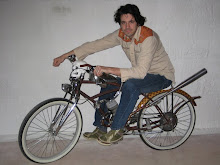




The top plate is just about done - just some clean up hear and there to do to make it look pretty.
The very top picture shows how I made the treble side braces into I Beams. The treble side will respond better to higher frequencies if it is light or stiff or both. How can I carve the Spruce top to be light and still maintain stiffness. I addressed this conundrum by carved a narrower recurve area (thinnest area at the outside edge of the sound plate) than the bass side and the spruce is also a bit thinner as it approaches the center of the plate where the two halves are joined. The treble side is much shorter than the bass side and therefore lighter. I made the braces shorter too but left them tall and tapered them thinner than the bass side. I also routed out the middle of the braces and made them into I Beams. I didn't loose any stiffness and I shaved about 2.5 grams off the weight.
The Bass side theory is that it will respond better to lower frequencies if it is less stiff or heavy or both. Think about that...the bass side will respond to lower frequencies if it is heavy or not stiff or both. How can you have the Spruce top be less stiff and yet remain heavy. If I carve it heavy than it will be stiff. So, what I did was carve a wider recurve area, when compared to the treble side, at about 1/8" thick and then added longer wider but less tall braces. Now the spruce plate is thinner but with heavy braces that are also more flexible than the treble side if the plate. Also, because the guitar is a single cutaway the bass side of the sound plate is much longer than the treble side and therefore heavier.
The other pictures show how the lightning bolts are cut. I use my MDF plate pattern. I mark out where the bridge location will be and layout the f holes so that their center is in line with the bridge. I cut out the shape into the pattern and then tape the spruce top on to it with double sided tape. With my overhead router I cut the shape out. The pin in the router bed follows the MDF pattern and the cutter, located directly above the guide pin, cuts out the shape in the Spruce.
This procedure always scares me because you work somewhat blindly and it is touch and go when you are routing sharp points - wood sometime doesn't like being cut across the grain while it's vibrating like mad. It's a rush.
I then finish the sharp corners of the lightning bolts with a fresh Exacto knife and hone it up with some sanding and or needle files. The next step is to glue on the solid Ebony binding. The Ebony is all mitered together and adds to the stiffness of the opening which is a good thing because these areas are thin.






No comments:
Post a Comment